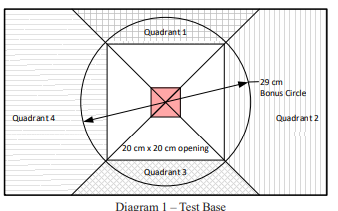Sci Oly Tower Rules
1/14
There's no tags or description
Looks like no tags are added yet.
Name | Mastery | Learn | Test | Matching | Spaced |
|---|
No study sessions yet.
15 Terms
What are the basic requirements for the Tower structure?
- Made of wood bonded by adhesive
- Spans 20 cm square opening
- Supports loading block 50+ cm above test base
- Only 3 points of contact with the test base

What materials are allowed for construction?
- Only wood and adhesive
- No other materials permitted
What are the key structural design requirements? (Rule 3.b)
- 3 points of contact with test base
- Loading chain suspended within 2.5 cm of opening center
- Minimum 50 cm height
- Designed for 29 cm bonus circle
What are the Loading Assembly specifications? (Rule 5.b)
Loading Block: 5 cm x 5 cm x 2 cm high
- Eyebolt for suspension
- Chain and S-hook for attaching to structure
What are the Test Base specifications? (Rule 5.a)
- Solid, level surface
- At least 55 cm x 32 cm
- Divided into 4 quadrants
- 29 cm bonus circle centered on opening
What are the key competition procedures? (Rule 4)
- Structure inspection & measurement
- Mass determined to 0.01 g
- Height measured to 0.1 cm
- 6 minutes for setup and testing
What are the Event Parameters? (Rule 2)
- One Structure per team, built prior to competition
- Eye protection required at all times
- No commercial levels or squares allowed
- All Apparatus must meet requirements in Section 5
Define "wood" as per competition rules. (Rule 3.a.ii)
- Hard, fibrous substance from tree trunks and branches
- Includes bark, particleboard, plywood, paper
- Excludes grasses, bamboo, cork, wood composites
- May not be painted, soaked, or chemically treated
What are the specific rules for adhesives? (Rule 3.a.iii)
- Used to join two or more materials
- Examples: cement, hot melt, cyanoacrylate, epoxy
- Commercially available only
- Adhesive tapes are not allowed
What are the Loading Block specifics? (Rule 5.b.i-ii)
- 5 cm x 5 cm x ~2 cm high
- Hole no larger than 8 mm diameter on top face
- 1/4 inch threaded eyebolt (1-inch nominal eye outside diameter)
- Eye bolt extends 1/2 inch to 2 1/2 inch above block
Describe the chain and loading mechanism. (Rule 5.b.iii-iv)
- Chain and S-hook suspended from eyebolt
- Bucket with handle attached to S-hook
- Bucket approximately 15 cm high x 14 cm diameter
- Spring-type clothespin for sand loading
What are the scoring components? (Rule 6)
- Load Score = Load Supported / Mass of Structure
- Load Scored Bonus for structures within 29 cm circle
- Estimated Load Supported used as tiebreaker
- Structures ranked in tiers based on construction parameters
What happens during Part II: Testing? (Rule 4, Part II)
- 6 minutes to set up and test
- Structure placed on Test Base
- Loading Assembly attached
- Sand loaded until failure or time expires
- Participants may not touch bucket during loading
What constitutes a "Structure Failure"? (Rule 4.j)
- Unable to carry additional load
- Any part of load supported by anything other than structure - Deflection of chain/eyebolt touches bucket
- Sand pours out after structure settles